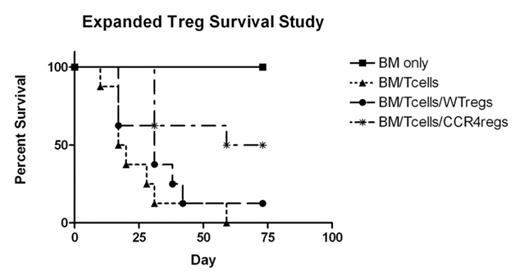Abstract
Chemokine Receptor 4 (CCR4) has been shown to be important for the homing of effector T-lymphocytes (Teffs) to cutaneous and possibly pulmonary sites of inflammation. CCR4 is also expressed on the surface of regulatory T-lymphocytes (Tregs), and previous work has suggested a critical role for CCR4 for their in-vivo suppressive ability. Since the skin and lung are important sites of graft-versus-host disease (GVHD) morbidity, we set out to determine the contribution of CCR4 to both Teff and Treg function in a murine stem-cell transplant model.
Methods: C57BL/6 (B6) mice served as bone marrow (BM) donors, and B6xDBA/2 F1 (B6D2) mice functioned as recipients. Teffs and Tregs were obtained from wild-type (WT) or CCR4 knockout (CCR4−/−) B6 mice. For Teff studies, recipient animals were lethally irradiated and administered T-cell depleted (TCD) BM cells +/− splenic Teffs from WT or CCR4−/− donors. For Treg studies, mice received TCD BM + WT Teffs +/− naive or expanded Tregs from WT or CCR4−/− donors.
Results: Animals receiving WT or CCR4−/− Teffs all developed severe GVHD with an 88% mortality rate. Using flow cytometry, we demonstrated that WT and CCR4−/− eGFP+ Teffs were able to accumulate in the skin and lungs of recipient animals at a similar frequency, suggesting a non-essential role for CCR4 in Teff homing to these sites. Attention was next directed towards the influence of CCR4 on Treg function in-vivo. Those animals receiving BM and Teffs without Tregs developed aggressive GVHD with 100% mortality. In contrast, when animals were administered BM and naïve Tregs from either WT or CCR4−/− donors two days prior to receiving Teffs, all animals demonstrated 100% survival and only mild GVHD, suggesting a non-obligatory role for CCR4 for Treg function in-vivo. Since CCR4 is upregulated on Tregs and Teffs after activation, we next examined whether its absence would exert a greater effect on the ability of expanded Tregs to protect against GVHD in-vivo compared to naïve cells. Animals were irradiated and received TCD BM plus Teffs +/− Tregs from WT or CCR4−/− donors previously expanded in-vitro. Those animals receiving BM and Teffs without Tregs all developed severe GVHD with 100% mortality. Ex-vivo expanded WT Tregs, 80% of which expressed L-selectin at low levels, provided only marginal GVHD protection with 12.5% survival when given concurrently with Teffs at a 1:1 ratio. In contrast, expanded CCR4−/− Tregs provided superior in-vivo GVHD protection, with 50% of mice surviving long term (see figure, p=.05 for WT versus CCR4−/− Treg groups). This enhanced protection in-vivo occurred despite an inferior ability of expanded CCR4−/− Tregs to inhibit T-cell proliferation in an in-vitro mixed lymphocyte reaction compared to WT cells. Migration studies did not reveal a difference in the trafficking of expanded CCR4−/− Tregs compared to WT cells except for a greater frequency of CCR4−/− Tregs in the mesenteric lymph node on day +7.
Conclusions: Our data suggest that naïve CCR4−/− Tregs are as efficient as WT cells in preventing GVHD, and that CCR4 is not required for the induction of GVHD by Teffs. Paradoxically we show that expanded Tregs function better to prevent GVHD in the absence of CCR4. Current work is underway to determine the mechanism for this finding.
Author notes
Disclosure: No relevant conflicts of interest to declare.


